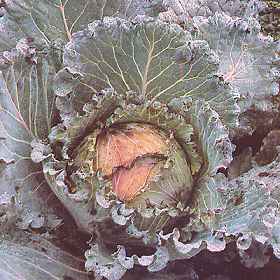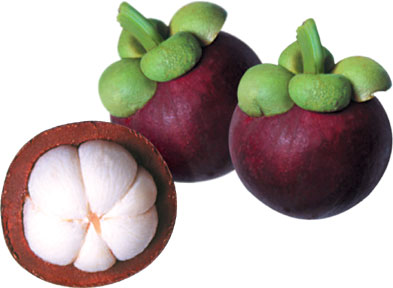The World Need Us To Green It Once Again....
Nature is wise, and if we take the time to observe it, we can learn so much
Thursday, March 25, 2010
Visitors are welcome to give comments
Thursday, March 18, 2010
Growing Cabbage
 | The variety to the left is January King a hardy winter variety with heads which are crispy and crunchy and full of flavour. |
The somewhat unglamorous reputation gained by cabbage has changed over the last few years, newer varieties have been introduced which are milder tasting than the old much stronger flavoured types, these varieties have also been bred to be more disease resistant.
Because the cabbage is suitable to most temperate climates and soils and require minimal attention, they are one of the easiest crops to grow.
Monday, March 15, 2010
Mangosteen – Garcinia mangostana

The mangosteen (Garcinia mangostana) is a tropical evergreen tree, believed to have originated in the Sunda Islands and the Moluccas. The tree grows from 7 to 25 meters tall. The edible fruit is deep reddish purple when ripe. In Asia, the mangosteen fruit is known as the “Queen of Fruits.” for its indescribably delicious flavor. It is closely related to other edible tropical fruits such as button mangosteen and lemondrop mangosteen.
Mangosteen is so easily available here. When I was small, I used to have a few mangosteen trees around the house. We just need to pluck them from the trees. Those over-ripened fruit will drop and I picked them from the grounds in the morning. It is fun to walk through the wet grass to search for mangosteen. (the fruits that had dropped cannot be stored and should be eaten immediately)
The price of mangosteen varies according to supply. Sometimes a fruit costs a mere 10 sen and it can be as high as 50 sen too.
Overhere, it is eaten as fruit. However, I read on the internet that it has medicinal value. I am not sure about that but the old folks always remind us children to eat some mangosteen after taking durians to counter the ‘heat’ of the durians.
I don’t really like mangosteen because of the sap and red juices from its skin. However, it is a very tasty fruit, unique in its own taste.
Sunday, March 14, 2010
What is Mint?

An herb is a plant whose leaves, seeds, or flowers are used for flavoring food or in medicine. Other applications of herbs include cosmetics, dyes, and perfumes. The word derives from the Latin herba, meaning "green crops." With species in the mint genus native to Australia, North America, Europe, and Asia, mint is an herb that includes more varieties than just the popular spearmint and peppermint. In fact, many other herbs used as seasonings come from the same family (Lamiaceae), including basil, catnip, oregano, rosemary, and sage; while wintergreen, which might be expected to be related to mint, is actually from a different family.
History. Unsurprisingly, mint was chewed as a breath freshener early in history. Ovid recounts the story of a nymph named Minthe or Menthe who was about to be seduced by Hades, God of the Underworld, when his wife, Persephone, coming upon them, turned her into a plant. Mint was used in Ancient Greek funeral rites, as well as in an ancient fermented barley drink.
Description. Members of the mint family produce green bushy plants. While most varieties attain a height of 1-3 feet, they are nevertheless sometimes used as ground cover. Leaf color varies by species, and the flowers may be white, pink, or lavender.
Gardening. The members of the mint family are hardy perennials with a tendency to spread, and gardeners may choose to confine them to containers for this reason. Popular types include spearmint, peppermint, and bergamot, as well as citrus- and pineapple-flavored mint, and even chocolate mint. They grow well in moist, well-drained soil, and in partial shade. Because mints cross-pollinate, producing seeds that are often of poor quality and not true to type, it is best to deadhead the flowers and to propagate using division, root cuttings, or runners.
Food and other uses. Many varieties of fresh and dried mint are used as seasonings in a variety of cuisines, from Indian and Southeast Asian curries and Middle Eastern tabouleh to Greek keftedes, British lamb with mint sauce, and the Southern US mint julep. Leaves are also infused to make a drink variously referred to as herbal tea or tisane, and as the flavoring component for mint jelly. While mint is used as flavoring in toothpaste and medicines to treat stomach complaints, menthol, made from mint oil, is used in over-the-counter products for coughs, in lip balms, and in mouthwashes. The variety of mint called pennyroyal should not be ingested, but is used as a flea repellent.
Preservation. Drying is not ideal for every herb, but it works well for mint. Harvest before the plants bloom; cutting the stems; tying them together; and hanging them from hooks on or near the ceiling for about a week in a warm, dry, dark location until they are crisp. Some people use the leaves only, while others use the stems as well. Store in a cool, dark place in an air-tight container with a desiccant added.
Thursday, March 11, 2010
Save Earth Now.........
Crisis: Earth's global ecology is fast approaching a point of no return.
We are beyond the point of negotiating and mitigating to appease local communities, corporations and politicians. That has not worked to turn the tide of destruction facing our global ecology. We are past the point where bureaucratic battles alone will protect us.
We all know the health of our species is related to the health of the environment. There is a direct connection between pollutants like pesticides and chlorine, and the growing health crisis of cancer and respiratory ailments.
Saving the planet requires imagination, a new attitude and new way of life. It requires real information and common sense actions that people can take to make a difference. It requires commitment to a new lifestyle, a new and BETTER economy based on environmentally sound products and companies.
Our fragile planet has a limited capacity to provide for us. Save Earth Now has real information and common sense actions that people can take to help save our Earth now!
TREE PLANTING TIPS

Plant the Future with a Tree A single tree can do wonders for your home and garden. It can provide colorful fall leaves, flowers, fruit or nuts and raise your real estate value. it can be an environmentally wise summer air conditioner for your home. A tree is a marvelous creation! Trees also help process carbon dioxide and turn it back into oxygen. This is a very important reason to plant trees in our yards, parks and cities. Consider giving trees as anniversary presents, to commemorate important dates in the lives of friends and families or give one or more as a house-warming present. Planting trees just makes a lot of sense. And fall is the best time for planting trees...so join in the future!
Several trees to consider for your garden for spectacular fall color are:
- Chinese Tallow Tree: Sapium sebiferum one of tghe benefits of this tree is the brilliant autumn foliage it provides. Choose from flaming red, bright yellow, purples and oranges. It is hardy to 10-15 degrees.
- Chinese Pistache: Pistacia chinensis. Pistache trees are known for their show-stopping autumn foliage. They require no summer watering once tey are established and do best with deep infrequent watering.
- Sweet Gum: Liquidamber A popular street tree with a cone shaped growth habit. Spreading with age, it provides brilliant fall foliage. Leaves color best when trees are in full sun and well draining soil. Fall color is less brilliant in milder climates.
How to Successfully Plant a Tree
These tips are provided by the California Association of Nurseries and Carden Centers, and California ReLEAF
- Dig the planting hole two times wider than the container or root ball of the tree. Make vertical sides to the hole and roughen them so the roots can penetrate.
- Remove the container just before the tree is put into the hole. Move the tree by the root ball rather than the trunk. Minimize the time the roots are exposed to air. Roots circling around the outside of the rootball should be cut vertically in five places around the circumserence. Cut off matted roots fromt he bottom of the root ball.
- Set the root ball on undisturbed soil. Adjust the best side of the tree to face the direction you want. Make sure th top surface of the root ball is one inch higher than the natural soil grade. lay a stick or shovel handle across the hole to see if the root ball is high or low.
- Fill the hole in and around the root ball with the soil you removed from the hole in Step One. If the soil is filled with rocks, rake out the larger ones. Break up any clods and mis them with good topsoil. Firm the soil around the tree's root ball until the hole is two-thirds full.
- Fill the remaining space with water. Finish filling the hole with soil, but do not tamp. No fill soil shoud be put on top of the root ball.
- Mound what soil is left into a six-inch high berm around the edge of the planting hole. Fill the basin around the tree with waer to wet and settle the soil.
- Place a three-inch layer mulch (bark or organic compost) around the tree. mulch helps control weeds and retains water in the soil. Keep lawns 18 inches away from the trunk.
- Remove the stake that came with the tree. Restake your tree only if the tree cannot support itself. use two stakes and palce them 12 inches away from the trunk on either side to support the tree against the wind. Use soft flexible garden ties to secure the tree to the stakes.
How to Grow Fig Trees
Step 1: Purchase the Fig Trees
Figs are a delicious and healthful fruit, and the trees are nearly maintenance free. The trees come in different sizes, from dwarf figs that reach only 6' tall to ones that top out at 30'. Popular varieties include Hardy Chicago, Celeste and Brown Turkey. Select a variety that is appropriate for your climate. Most gardeners plant them from bare-root trees.Step 2: Prepare the Site
Pick a well-drained spot that gets at least eight hours of sun a day for good fruit production. If the soil is very clay-like, work in organic amendments to make it looser. When planting one of the larger varieties, make sure to give the tree plenty of room to grow.
Step 3: Plant the Fig Trees
Hose off any material clinging to the roots (Image 1). Soak the roots in a bucket of water for an hour or two before planting. Dig a hole a few inches deeper than the roots and at least as wide as the roots when fanned out. Place the tree in the hole and spread out the roots. Position the point of the trunk where the roots begin to spread out just below the soil line (Image 2) . Backfill with soil until the hole is three-quarters full. Wate
Step 4: Cultivate the Fig Trees
Add a layer of mulch around the base of the trees. Maintain a consistent level of moisture during the tree’s first year. If the soil becomes dry, water the tree well. Light applications of 10-10-10 fertilizer can be applied in the late winter, spring and early summer. Figs don't need much pruning, just enough so as to control the size.